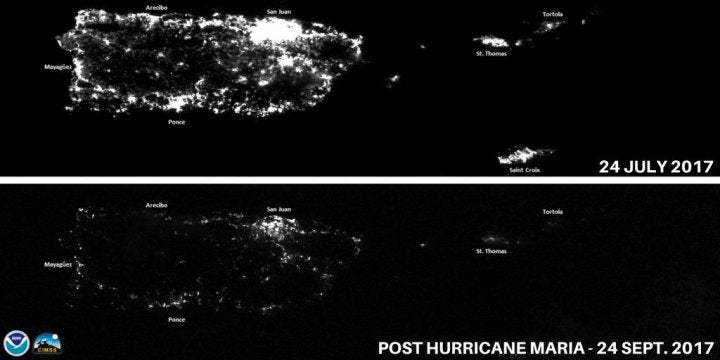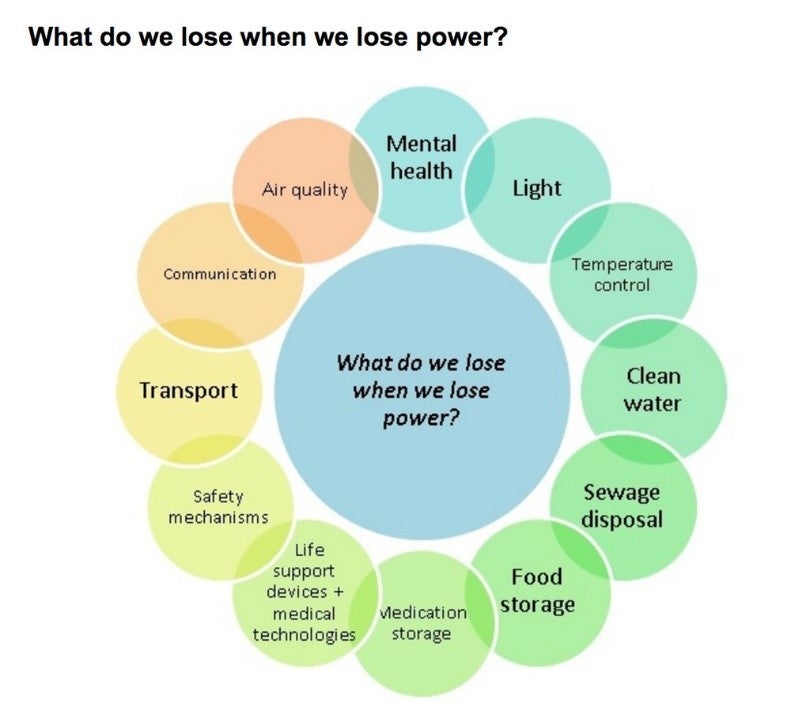
Power Down in Puerto Rico
It has been almost a week since Hurricane Maria devastated the island of Puerto Rico. While the storm may be over, the struggle to restore power and rebuild the electric grid will continue for weeks and months to come. Officials estimate that it could take a minimum of four months, but likely six months, to recover the grid. Local officials have called the current conditions “apocalyptic.”
There are 12 power plants on the island, all of which suffered damage. The biggest problem, however, is not with the plants themselves but with the transmission lines. There are over 2,400 miles of transmission lines and more than 30,000 miles of smaller distribution wires. All told, more than 80% of transmission and distribution lines were knocked down by the storm. With the extensive damage, this is a rebuilding effort more than a repairing effort. The few locations on the island with power are using generators. PREPA, Puerto Rico Electric Power Authority, estimated that about $4 billion is needed to upgrade the energy infrastructure.

Puerto Rico relies almost wholly on fossil fuels for power generation; over 98% of Puerto Rico’s energy generation is from fossil fuel sources. Renewable energy and decentralized sources can help communities recover faster after storms and major power loss events. Still, according to the International Monetary Fund, over half of Caribbean island nations rely almost exclusively on fossil fuels.
Even before the hurricane, Puerto Rico has had a vulnerable electric grid. For years, Puerto Rico has been cutting corners and diverting money away from the public electrical utility which has led to an inefficient and unreliable system. The budget is “discretionary,” recordkeeping is “subpar,” and PREPA has lost over 30% of its workforce since 2012 to retirement and mainland jobs.
PREPA is already more than $9 billion in debt and filed for bankruptcy in July. Last year, a report commissioned by the Puerto Rico Energy Commission, outlined problems with PREPA, specifically the poor reliability. Power outages are four to five times more frequent than mainland U.S. due to “a history of neglecting maintenance.” Over a third of power outages were caused by lack of upkeep of trees around power lines, an example of an easily solvable problem if the proper funding for maintenance was available.
Puerto Rican customers also are expected to pay rates higher than all mainland U.S. states, second only to Hawaii. With almost all their power coming from dirty fossil sources, Puerto Ricans also pay in through polluted air and water. There is plenty of research showing that pollution of air and water can lead to negative health impacts on the community, ecosystem, and thereby the economy.
As the 3.4 million residents grapple with multiple months without electricity, there are serious implications for public health, sanitation, security, food storage, and other essential services.

But likely the most crucial is the impact to public health services. Those waiting for surgeries will be postponed. There will likely be an uptick in diarrheal diseases and food poisoning due to spoiled food. Diabetes patients will struggle to keep their insulin cold. We rely on energy every day to keep people safe and healthy.
In addition to the storm and infrastructure problems, Puerto Rico is also dealing with a bankruptcy issue. This will only be further complicated by the storm. With the prolonged power outage, the economy will suffer, most especially the tourism industry. Not to mention that there could likely be a drain of young Puerto Ricans who move to mainland U.S. in search of better opportunities; there has already been an 8% population decline since 2010. Fewer workers means less tax revenue and more economic problems for the island.
As we prepare for a world with more intense storms, we can also expect more serious power outages. And if investments are not made in energy infrastructure, the problems will only expand and worsen.
Mollie Simon
Senior Communications SpecialistMollie Simon is the senior communications specialist at the Kleinman Center. She manages the center’s social media accounts, drafts newsletters and announcements, writes and publishes content for our website, and regularly posts to our blog.

